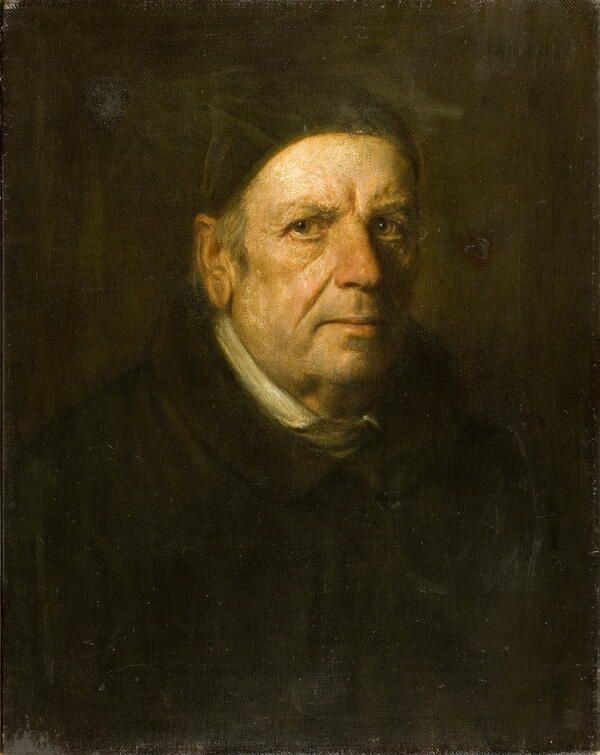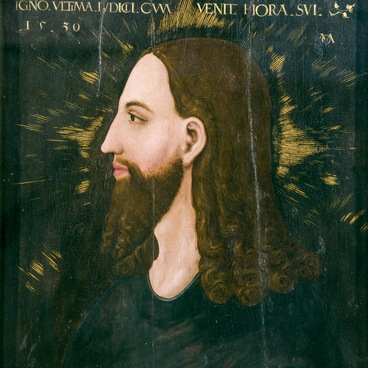“Portrait of an Old Man” by Franz von Lenbach is not dated but it is very close in style to the artist’s “Self-Portrait” of 1866. The painting is a deep study of the sitter’s personality. The artist intended not only to depict the man’s appearance but also to capture his spirit and mood. The warm golden color palette and the forms meticulously modelled using light and shadow reveal the influence of Rembrandt’s Baroque portraits.
Franz Lenbach, one of the most prominent representatives of the Munich School, was born into the wealthy family of a Tyrol architect. From an early age, he enjoyed painting. Lenbach learned the profession of a mason and worked at a family business. At the age of 17, he entered the Academy of Fine Arts in Munich where he studied painting and composition under a master of the history genre.
After selling one of his first successful paintings “A Peasant Seeking Shelter from Bad Weather” and receiving a grant from the Academy, Lenbach traveled across Italy. There he created two remarkable paintings en plein air: “The Goatherd” and “The Arch of Titus”. After that, he spent six years making copies of the old Italian and Spanish masters for his patron. During this period, Lenbach closely studied the art of Titian, Rubens, and Velázquez, which had a great impact on developing his own style.
The distinctive artistic style of Franz Lenbach was first displayed in the portrait of his sister Josephine. For this painting, the artist was awarded with a Gold Medal at the 1867 Exposition Universelle in Paris. Lenbach worked on refining his style, constantly experimented with color, striving to highlight the face and eyes of a sitter. He became extremely popular in Munich and later achieved international fame with his vivid portraits of monarchs and famous contemporaries, including Richard Wagner and Franz Liszt. Lenbach became a true historiographer of his time and created around a hundred portraits of his lifelong friend Otto von Bismarck.
As a result of his wealth and high social status, the artist was awarded an order of merit and became known as “Franz von Lenbach”. He built a mansion in the style of a Renaissance castle. Known as the Lenbachhaus, it is located in Munich and currently houses an art museum.
Franz Lenbach, one of the most prominent representatives of the Munich School, was born into the wealthy family of a Tyrol architect. From an early age, he enjoyed painting. Lenbach learned the profession of a mason and worked at a family business. At the age of 17, he entered the Academy of Fine Arts in Munich where he studied painting and composition under a master of the history genre.
After selling one of his first successful paintings “A Peasant Seeking Shelter from Bad Weather” and receiving a grant from the Academy, Lenbach traveled across Italy. There he created two remarkable paintings en plein air: “The Goatherd” and “The Arch of Titus”. After that, he spent six years making copies of the old Italian and Spanish masters for his patron. During this period, Lenbach closely studied the art of Titian, Rubens, and Velázquez, which had a great impact on developing his own style.
The distinctive artistic style of Franz Lenbach was first displayed in the portrait of his sister Josephine. For this painting, the artist was awarded with a Gold Medal at the 1867 Exposition Universelle in Paris. Lenbach worked on refining his style, constantly experimented with color, striving to highlight the face and eyes of a sitter. He became extremely popular in Munich and later achieved international fame with his vivid portraits of monarchs and famous contemporaries, including Richard Wagner and Franz Liszt. Lenbach became a true historiographer of his time and created around a hundred portraits of his lifelong friend Otto von Bismarck.
As a result of his wealth and high social status, the artist was awarded an order of merit and became known as “Franz von Lenbach”. He built a mansion in the style of a Renaissance castle. Known as the Lenbachhaus, it is located in Munich and currently houses an art museum.



